Ludosport International, a Cartoomics 2018, ha presentato A story of light: Polaris.
Un fumetto metadimensionale, in cui i protagonisti sono gli atleti del network di combattimento sportivo con spada laser, disegnato dalla bravissima Valeria Favoccia!
Polaris è un’opera che vede alle penne Valeria Favoccia, talentuosa e giovanissima disegnatrice, che si è già fatta notare per le sue pagine di Assassins’ Creed, e Doctor Who, edite da Titan Comics.
Vi consigliamo di cercare i suoi lavori, a partire dal brevissimo e toccante fumetto ‘muto’ Knight, senza dimenticare le grafiche realizzate per alcuni giochi in scatola.
Ecco la nostra intervista:
A story of light: Polaris è un progetto innovativo, che combina fantasia e realtà, mostri ed atleti, avventure virtuali ed allenamenti in palestra e, tante, tante, lame di luce!
Guidare lo sguardo del lettore è sempre una sfida, in particolare nelle pagine che prevedono combattimenti.
Quanto studio preparatorio è necessario per comporre tavole dinamiche ed intriganti?
E’ una domanda molto difficile perchè principalmente disegnare tavole di qualsiasi genere richiede anni di studio e di preparazione, ovviamente.
Personalmente mi sento più nel mio elemento quando si tratta di dover illustrare scene d’azione, in quanto amo le pose dinamiche.
Amo disegnare gli scontri e adoro le sequenze di lotta. Quindi essere chiamata a rappresentare una saga di duelli con spade laser, per me era come se fosse Natale!

Un aspetto importante del progetto Polaris è la sua gestazione tramite crowdfunding (clicca qui per info).
Dare forma ad un’idea, in cui molti hanno creduto già molto tempo prima che il progetto prenda vita, è stimolo, responsabilità od orgoglio? Tutte e 3 le cose ed altro ancora? 🙂
Credo sia un mix delle tre cose!
Personalmente è la prima campagna a cui partecipo da autrice e sono entusiasta della risposta calorosa del pubblico e della loro fiducia.
Nel contempo mi impegno molto affinché le aspettative siano ben riposte.
Quando si partecipa ad una campagna di crowdfounding, molto spesso si compra a scatola chiusa un prodotto di cui si conosce relativamente poco. Spero che il risultato sia all’altezza !!

Hai avuto modo di testare il combattimento sportivo con spada laser?
In qualche modo, ti è servito per approcciarti meglio a Polaris?
Sì, i ragazzi di LudoSport, ancora prima di cominciare a parlare del progetto, mi invitarono ne “La Cripta” per partecipare ad una lezione come allieva.
Fu interessante perchè riuscii a comprendere meglio le persone dietro questo sport, la loro dedizione ed il loro “codice” di combattimento.
Oltre ovviamente a poter assistere dal vivo alle tecniche delle varie forme di cui si forgia questa disciplina.
Mi aiutò molto a darmi un’idea generale delle movenze e degli atleti che costituiscono questo mondo fantascientifico.
Cosa ti ha affascinato di questo progetto?
Il fatto che sia un vero e proprio universo a sé stante, quindi la possibilità di poter plasmare mondi e personaggi da zero, è stato molto stimolante!
Disegnare fumetti è un’arte che si è molto evoluta negli ultimi anni, con l’ausilio dei computer: matita e china hanno lasciato il posto a tavolette grafiche, software e font digitali prodotti da ditte specializzate.
Di quali strumenti ti avvali nel tuo lavoro e quanto ricorso fai ai ‘vecchi’ attrezzi del mestiere?
Principalmente realizzo quasi tutto su Manga Studio, usando la mia Cintiq 22HD della Wacom, mezzo indispensabile ormai per il mio lavoro.
Anche e soprattutto considerate le tempistiche strette con cui siamo soliti ad avere a che fare.
Solitamente uso la matita ed il foglio per le primissime bozze, ovvero dei mini-storyboard, grandi più o meno 4 cm di alcune tavole consecutive.
Questo mi aiuta a rendermi meglio conto della continuità delle sequenze e delle azioni, prima di trasporle in digitale singolarmente e lavorarci fino alla tavola definitiva inchiostrata.
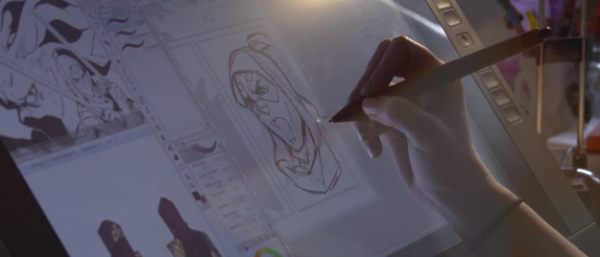
Quali sono pregi e difetti, se esistono, delle nuove tecnologie rispetto ai metodi tradizionali?
Come dicevo prima, sicuramente un grande pregio è quello di riuscire ad accelerare i tempi, evitando diversi passaggi o agevolando eventuali modifiche o ripensamenti in fase di realizzazione del definitivo.
Non saprei elencare dei difetti, personalmente :D!
Non sono una di quelle che soffre il “contatto con la materia”, mi trovo benissimo con i mezzi con i quali lavoro e mixando le due cose per le diverse fasi del lavoro, trovo che sia un perfetto connubio per le mie necessità. Forse l’unica “pecca” è di non essere (ancora) riuscita a trovare un pennello che mi soddisfi e che renda più “realistico” il tratto, più “materico” appunto.
Ma ci sto lavorando. La ricerca stilistica non finisce mai!
Nell’ambito della storia dei fumetti, chi sono i tuoi artisti ‘stelle polari’, quelli di cui consiglieresti le opere; quelli che sono, per te, imprescindibili nel vasto universo dei comics?
E quali caratteristiche ti colpiscono, nel loro lavoro?
E’ una domanda difficilissima perchè vengo da sempre e costantemente investita, ispirata e indirizzata da una miriade di artisti, a volte completamente diversi tra loro, la lista sarebbe veramente infinita!
“Storicamente” posso dire di essere stata ispirata da Lorenzo Pastrovicchio e Claudio Sciarrone, in primis, sulle pagine di PKNA, quando ero ancora una bambina che realizzava di poterne fare un lavoro per la vita.
Il loro tratto era molto vicino a quello americano, fortemente unico e distinguibile da quello di tanti altri autori, gettò le basi per quello che sarebbe stato il mio cammino nei comics.
Continuai con Leinil Francis Yu sugli X-Men e Alessandro Barbucci sulle W.i.t.c.h., che all’epoca per me quest’ ultimo fu fautore di una vera e propria rivoluzione, in quanto capii che era possibile avere anche un tratto ibrido.
Tra quelli che ammiro e che sono stati iconici successivamente, in ordine sparso, ci sono: Roberto De Angelis, Sara Pichelli, Carmine Di Giandomenico, Shirow Miwa, Tsutomu Nihei, Stuart Immonen, Mathieu Lauffray, Oh!Great (e potrei andare avanti così per giorni 😀 !)
Ultimamente invece, seguo molto Sean Gordon Murphy, Greg Capullo, Olivier Coipel e Jorge Jimenez .
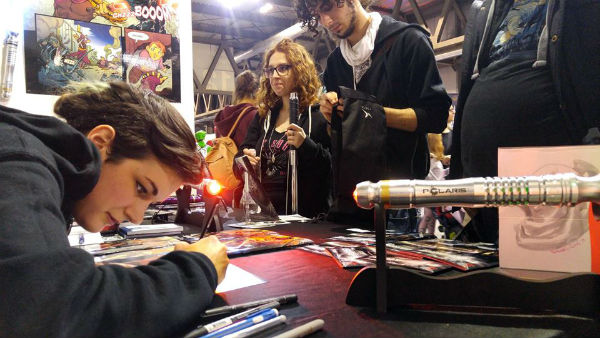
Se, invece, ci allarghiamo al mondo dell’arte in generale? Quali artisti (pittori, scultori, fotografi, registi) sono al centro della tua attenzione?
Sono un po’ lontana dalla scena contemporanea dell’arte (nel senso di esserne tristemente poco ferrata).
Ma se facciamo un quadro generale, i nomi di rappresentanza, in ordine sparso, che sono comunque di ispirazione da sempre sono: Michelangelo, Duchamp, Leyendecker, Burri, Cellini, Rae, Raphael Lacoste, Jeff Simpson, Alexander Lozano, Matteo De Longis, Refn, Tarsem, Guillermo del Toro, George Miller, Bryan Fuller, Frank Maddocks, Satoshi Kon, Katsuhiro Otomo.
C’è una testata fumettistica o un personaggio nei tuoi sogni od obiettivi futuri?
Su cosa stai lavorando attualmente, a parte Polaris?
Uno dei miei sogni si è avverato lo scorso anno, quando ho avuto l’onore di disegnare la serie celebrativa del decennale di Assassin’s Creed chiamata Reflections e continua ogni volta che vengo chiamata a collaborare per questo titolo.
Ma il sogno di una vita sarebbe quello di disegnare sulla testata di uno dei miei personaggi preferiti di sempre: Iron Man!
Attualmente sto lavorando ad un altro progetto per l’America, in parallelo a Polaris.
Purtroppo al momento non posso dire nulla al riguardo! Non vedo l’ora di poterlo svelare a tutti :D!
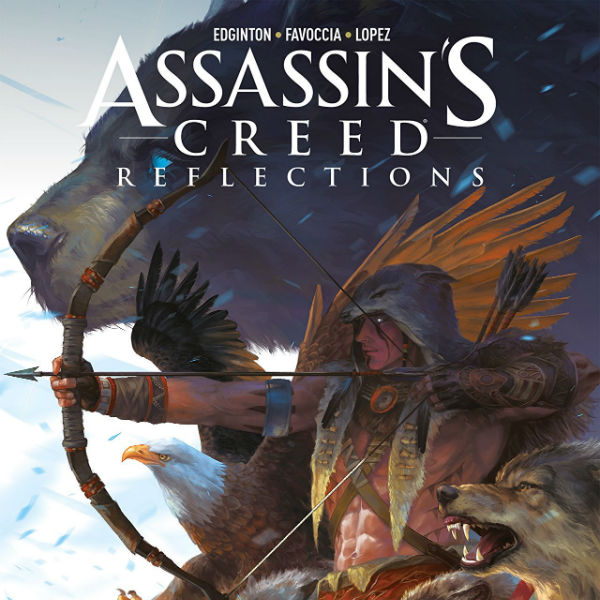
Una domanda che esula un po’ dall’aspetto prettamente fumettistico: il tuo nickname è Luxfero. Portatore di Luce, ma esplicito riferimento all’angelo ribelle scacciato dal Paradiso (o al personaggio DC/Vertigo?). Non un caso, certamente…
Ahaha, ti ringrazio per l’attenta trasposizione! E’ una cosa che risale ovviamente al liceo, quando ci si firmava tramite pseudonimi, ma l’ho tenuto sempre con me perchè in qualche modo ci sono affezionata e mi ci rispecchio tutt’ora.
Deriva proprio dal nome latino di Lucifero,“Portatore di Luce”, appunto. Sono sempre stata affascinata dal personaggio, dalla sua storia, dalla sua natura controversa e di quanto negativo suoni il suo nome nel quotidiano e nell’immaginario collettivo, quando invece ha un significato e un messaggio profondamente opposto.
Nel mio piccolo lo vedo anche come uno scopo, quello di riuscire a portare un po’ di luce in ogni cosa che faccio, a me stessa ed anche agli altri.
Come è essere donna nel mondo dei fumetti?
Credo non molto diverso dall’essere donna in ogni altro campo. Personalmente ho notato che a volte vengo sottovalutata per l’aspetto o non vengo presa troppo sul serio ad un primissimo impatto. Fortunatamente è il lavoro a dover fare la differenza e a dover dimostrare le proprie capacità, non le apparenze!
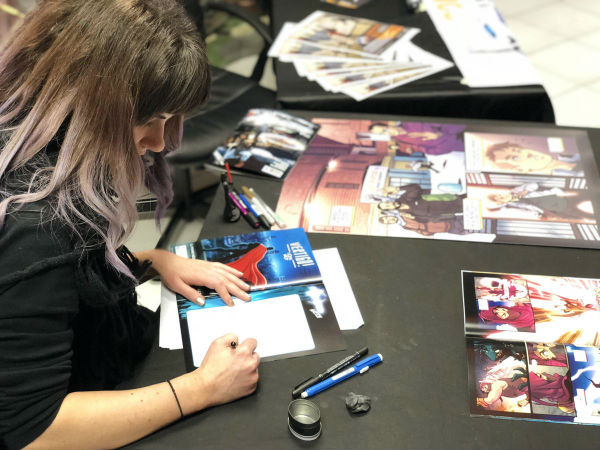
Qual è la collega che stimi di più professionalmente?
Ho tante colleghe che stimo fortemente, ma se devo scegliere un nome di rappresentanza, sicuramente è Sara Pichelli. E’ sempre stata un’ispirazione e la ammiro molto da fan, da fumettista e da compaesana.
Quale percorso consigli alle ragazze che vogliano intraprendere questa carriera?
Quello che consiglierei a chiunque abbia un sogno da realizzare: di lavorare sodo, di studiare tanto, di prepararsi ad una lunga strada in salita.
E di non mollare mai, nemmeno quando ci sono periodi così neri da far sembrare che non ne valga la pena.
Un saluto per le lettrici e i lettori di Nerdburger.it!
Ciao a tutti! Grazie mille per la gentilezza e buona lettura!
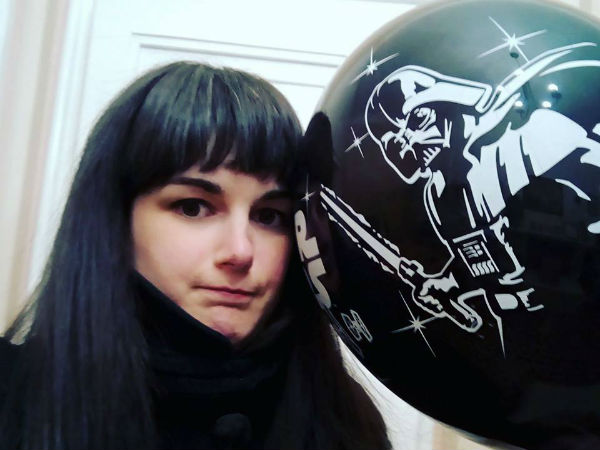
ENGLISH VERSION
Ludosport International, at Cartoomics 2018, presented A story of light: Polaris, a metadimensional comic book, in which the main characters are the athletes of this lightsaber combat network.
Polaris is an art-work by Valeria Favoccia, talented and very young comic book artist, who has already been noted for her pages on Assassins’ Creed, and Doctor Who, both published by Titan Comics.
We suggest you to look for her works, starting from the very short and touching ‘mute’ comic Knight, not forgetting the graphics made for several boardgames.
A story of light: Polaris is an innovative project combining fantasy and reality, monsters and athletes, virtual adventures and workouts in the gym and, many, many, lightsabers!
Driving the reader’s gaze is always a challenge, especially on pages packed with fights.
How much preparatory study is needed to compose dynamic and intriguing tables?
It is a very difficult question because drawing tables of any kind mainly requires years of study and preparation, of course.
Personally I feel more in my element when it comes to illustrate action scenes, as I love dynamic poses.
I love drawing clashes and I love the fight sequences, so being chosen to depict a saga of duels with lightsabers, for me, it was like Christmas!
An important aspect of the Polaris project is its gestation through crowdfunding: giving shape to an idea, in which many people have believed long before the project took life, is it stimulus, responsibility or pride? All 3 and more? 🙂
I think it’s a mix of the 3!
Personally, this is the first campaign in which I participate as an author and I am enthusiastic about the warm response of the public and their trust.
But, at the same time, I work hard to ensure that expectations are well placed.
When you support a crowdfunding campaign, very often you’re buying a pig in a poke, of which you know relatively little.
I hope the result is up to par!
Have you ever had the chance to test lightsaber sport combat?
If so, did it help you to better approach Polaris, in any way?
Yes, the guys from LudoSport, even before starting to talk about the project, invited me to “La Cripta” to attend a lesson as a pupil.
It was interesting because I was able to better understand the people behind the sport, their dedication and their “combat code”, as obviously being able to witness live the techniques of the various forms of which this discipline is forged, as well.
It helped me a lot to picture in me the general idea of the movements of the athletes that establish this fantastic world.
What fascinated you about this project?
It is a real stand-alone universe, so the chance to shape worlds and characters, starting from the very beginning, has been very stimulating!
Drawing comics is an art that has evolved in recent years, with the help of computers: pencil and china gave way to graphic tablets, software and digital fonts produced by specialized companies.
Which tools do you use in your work and how much appeal have the ‘old’ tools of the trade?
Mainly I realize almost everything on Manga Studio, using my Wacom Cintiq 22HD, an indispensable tool for my work.
Especially considering the close deadlines we are used to deal with.
I use pencil and sheet for the very first sketches, mini-storyboards, about 4 cm large of some consecutive tables.
This helps me to better realize the continuity of the sequences and actions, before transposing them digitally individually and working on them to the final inked table.
What are the strengths and weaknesses, if any, of new technologies compared to traditional methods?
Like I said before, certainly a great value is the possibility to accelerate times, avoiding several steps or facilitating any changes or aftertoughts in the implementation phase of the final work.
I can’t list any lack, personally: D!
I’m not one of those who suffer from the “contact with the material”.
I feel comfortable with the tools I work with and mixing the two different phases of the work, I find it a perfect match for my needs.
Perhaps the only “flaw” is that I have not (yet) managed to find a brush that satisfies me and that makes the tract more “realistic”, more “material” in fact.
But I’m working on it.
Stylistic research never ends!
In the history of comics, who are your ‘polar star’ artists, those whose works you would recommend? Those that are essential in the vast universe of comics, in your opinion?
What characteristics in their works affect you?
It ‘a very difficult question because I have always been constantly invested, inspired and directed by a myriad of artists, sometimes completely different from each other, the list would be really endless!
“Historically” I can say that I was inspired by Lorenzo Pastrovicchio and Claudio Sciarrone, first of all, on the pages of PKNA, when I was still a child who realized she could make this a job for life.
Their trait was very close to the American one, strongly unique and distinguishable from many other authors, it laid the foundations for what would have been my path in comics. I continued with Leinil Francis Yu on the X-Men and Alessandro Barbucci on W.i.t.c.h., which at the time, for me, was a real revolution, as I understood that it was possible to have an hybrid trait.
Among those I admire, in no particular order, there are: Roberto De Angelis, Sara Pichelli, Carmine Di Giandomenico, Shirow Miwa, Tsutomu Nihei, Stuart Immonen, Mathieu Lauffray, Oh! Great (and I could go on like this for days: D!)
Lately, however, I follow a lot Sean Gordon Murphy, Greg Capullo, Olivier Coipel and Jorge Jimenez.
Is there a comic book or a character in your dreams or future goals? What are you currently working on, apart from Polaris?
One of my dreams came true last year, when I had the honor of designing the serie celebrating 10 years of Assassin’s Creed ,called Reflections, and continues every time I come to collaborate on this title.
But the dream of a lifetime would be to draw one of my all-time favorite characters: Iron Man!
I am currently working on another project in the USA, along with Polaris, but unfortunately I cannot say anything about that, at the moment!
I can’t wait to reveal it to everyone :D!
A question that goes a bit far from comics: your nickname is Luxfero. Bringer of Light, but explicit reference to the rebel angel fallen from Heaven (or to the character DC / Vertigo?). Not a coincidence, of course…
Ahaha, thank you for the careful transposition! It ‘s something that goes back to high school, when you use to sign by pseudonyms. But I’ve always kept it because, somehow, I’m fond of it and I still find myself there.
It derives from the Latin name of Lucifer, “Bringer of Light”, in fact. I have always been fascinated by the character, by his story, by his controversial nature and how much negative his name sounds in everyday life and in the collective imagination, when he has a deeply opposite meaning and message.
Even in my own little, I see it as a goal: to be able to bring a little light into everything I do, to myself and to others.
What is like to be a woman in the world of comics?
I think it’s not very different from being a woman in any other field. Personally I have noticed that sometimes I am underestimated for the appearance or I am not taken too seriously at a very first glance. Fortunately it’s the job that has to make the difference and demonstrate abilities, not the appearances!
What colleague you respect the most, in your profession?
I have so many colleagues that I strongly respect, but if I have to choose a representative name, that is Sara Pichelli, for sure.
She has always been an inspiration and I admire her very much: like a fan, a cartoonist and a fellow countrywoman.
Which path would you recommend to girls who want to start this career?
It’s the same I would recommend to anyone with a dream to achieve: work hard, study a lot, prepare for a long uphill road and never give up.
Even when there are periods so black it seems it’s not worth it.
Salute the girls and boys who are reading Nerdburger.it!





Nessun commento